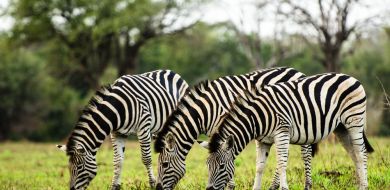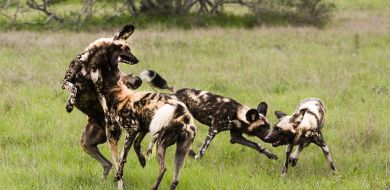Sabi Sabi Wild Facts: Dwarf Mongoose
on Dec 13, 2014These incredible creatures are the smallest carnivores in Africa, with a diet ranging from beetle larvae and termites all the way up to scorpions, snakes and rodents. They are often found living in old termite mounds where the temperatures remain pretty constant all year round, making for a comfortable home with central heating in the winter and air conditioning in the summer.
These highly social creatures live in groups of up to 30 individuals. The group has a strict hierarchy in which the oldest male and female are the alpha pair. This pair monopolises the breeding in the colony. A typical day for these little mammals begins with the alpha male coming out of the mound to check that all is safe, then going back into the mound to call out the rest of the family. He then marks each of the group with a secretion from a special anal gland, (which is also used to mark territory). This is vital to ensure that no strays come into his family group. In the evening he checks that there are no other mongooses coming to have a sleep-over!

After basking on the eastern side of their termite mound in the early morning sun, the mongooses move out to forage and constantly keep in touch with one another using whistles and twitters. If they spot any predator they give out alarm calls to let the rest of the family know they must get to cover. For each of the predators they have a different alarm call allowing the rest of the family to know from where to expect the danger. These mongooses have a mutualistic relationship, (relationship in which both species benefit), with Hornbills. Both species keep a lookout and warn each other of danger while feeding together.
There was a study done on the different alarm calls of the dwarf mongoose. A researcher noticed a variance between the calls in different geographic areas and wanted to investigate if there was any reason for this. Recordings of the various mongoose alarm calls related to particular predators in one region were played back to a group in a different geographic location. The new group recognised that there may be a threat but had no idea where the threat was coming from. The conclusion of the study was that the dwarf mongoose has different dialects according to geographic location.

Besides the Hornbill, the dwarf mongoose has a relationship with another bird, the Fork-tailed Drongo. This unique relationship is called kleptoparasitism, (parasitism by theft). The Drongo is able to perfectly mimic the alarm calls of the mongoose. As soon as it sees that a mongoose has caught a tasty morsel it imitates an alarm call, sending the mongoose scurrying to safety - leaving behind its meal. This then allows the Drongo to swoop in and steal its prize.
The colony also has another interesting mutualistic relationship; with Giant Plated Lizards. These lizards are basically mongoose-den housekeepers, eating the faeces of the mongooses and thereby leaving the termite mound hygienic. The lizards benefit from the relationship by obtaining left over nutrients from the faeces; and by having a great lookout point to warn them of any danger.






